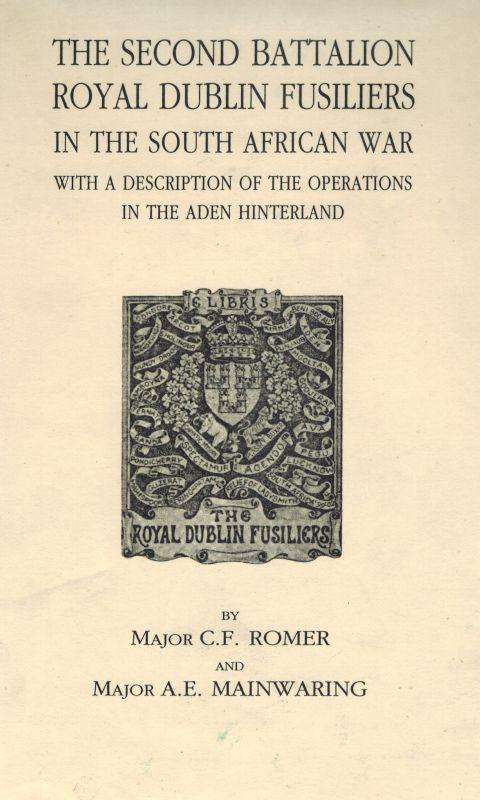Romer, The Second Battalion Royal Dublin Fusiliers in the South African War. Wit
The Second Battalion Royal Dublin Fusiliers in the South African War. With a Description of the Operations in the Aden Hinterland.
Reprint of original 1908 publication. Dallington, The Naval & Military Press, c2000 (unknown). 14,5 cm x 22,5 cm XIV, 271 pages. Original Hardcover with dustjacket. In protective mylar. Very good condition with only minor signs of external wear.
Includes for example the following essays: Talana / The Retreat from Dundee / From Colenso to Estcourt / Vaal Krantz / The Siege of Ladysmith / Aliwal North and Fourteen Streams / From Vryburg to Heidelberg / The Aden Hinterland etc.
Interesting ‘plain soldiers’ history of a battalion which served in South Africa throughout the Boer War. Detailed breakdown of deaths, wounds, and diseases and a description of ‘Winston Churchill’s armoured train’.The Royal Dublin Fusiliers (RDF) was formed in 1881, as a result of the Cardwell reforms, by the linking of the 102nd Royal Madras Fusiliers with the 103rd Royal Bombay Fusiliers, which became respectively the 1st and 2nd Battalions of the regiment. Both battalions traced their origins back to the Honourable British East India Company, the 2nd Battalion being descended from the Bombay Regiment, formed in 1661,the first of the Company’s European regiments. When the South African War broke out in 1899 the battalion was already in the country, having arrived in Natal from India in 1897, and so it had had time to get acclimatised and learn the topography of that colony. It remained in South Africa till the end of January 1902 and took part in the actions at Talana Hill, Colenso, Venter’s Spruit, Ladysmith, Hart’s and Pieter’ Hills and elsewhere. This book claims only to be a plain soldier’s narrative of the part taken by 2nd RDF – the fighting, the long and weary marches across the Transvaal and the monotonous life of constant vigil in fort, blockhouse and on escort duty. The appendices contain, among extracts from Battalion Orders, letters, telegrams etc, a detailed breakdown of casualties and this will be of great interest to medallists. There is also a description of the armoured train in which Winston Churchill was a passenger as a war correspondent just before he was captured by the Boers. The long list of those who died from disease gives place and date of death as well as the cause of death, e.g. dysentry, enteric fever and, interestingly enough, one struck by lightning and one suicide. The long list of the wounded not only gives date and place where wounded but also in most cases details of the wound; (in every case bar two shell splinter casualties, the wounds were caused by gunshot, which is a truibute to the accurate Boer marksmanship). There are lists of missing, reported at various dates, including 43 missing following the attack on the armoured train. (Publisher).
- Keywords: Catalogue Irish History Six – General Irish History · Catalogue Irish History Three – From Famine to Free State · Irish Military History · Royal Dublin Fusiliers · South African War
- Language: English
- Inventory Number: 71148AB
EUR 68,--
© 2025 Inanna Rare Books Ltd. | Powered by HESCOM-Software










